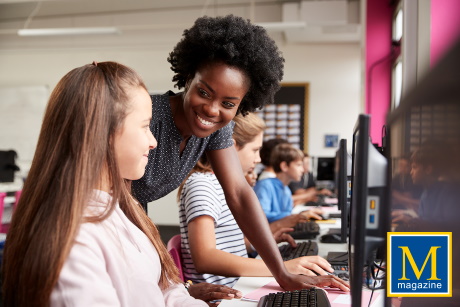Ty Howard

Copyright © by MOTIVATION magazine. All rights reserved.
If you are a teacher, especially in early education, elementary, middle, or high school level, you know how critical it is to deal with students in the classroom. Your actions need to be concise and precise. If you lose attention for a minute or more, the class can change into out lively mayhem. This increases the need for effective non-verbal communication skills to control your classroom because there are times where verbal actions from your side may create an awkward disruption in your teaching format at that moment.
One very effective non-verbal communication skill teachers used on me and other students when I was in grade school was the—Power of The Stare. The best teachers and most effective classroom managers around the world all understand and utilize eye contact skills like a mother training and developing her toddler. The 'Power of The Stare' clearly communicates: 1) I see you. 2) Stop it. 3) You know you can do much better. 4) I am thrilled and proud of you.
In this article, I share with you the four types of stares that the best teachers (classroom managers) use - even today - to leave a strong connection and impact on students.
STARE 1: The Direct Eye to Eye Contact Stare
The Direct Eye to Eye Contact Stare is done by the teacher when a student is trying to half-answer a question or pass of incomplete work in class. It serves as a form of correction and encouragement. You are interested in what the student is trying, and at the same time, you're encouraging him or her with your eyes to let them know, "You can do much better than this, and you know it." It gives the student the confidence which he or she is lacking. When a student receives The Direct Eye to Eye Contact Stare from a caring and supportive teacher, it gets their full attention. The student quickly senses that what he or she is doing is not their best effort, and you, the teacher, are letting them know.
Stare 2: The Side Eye to Eye Contact Stare
This stare is the most urgent one for a student. When a student is creating some disturbance, the teacher does The Side Eye to Eye Contact Stare. It is a polite, yet corrective warning for the student with a clear signal that I am going to get you if this signal goes un-respected. No one knows for whom this signal is because it is a very random one. The teacher is listening to someone else and, at the same time, has a clear eye on the student creating the disturbance.
Stare 3: The Short Squint Eye Contact Stare
This stare is usually a signal when a student is not focused on classwork and wasting time in class. When the teacher assigns any task in the classroom, everyone is supposed to complete it or at least try to complete it to the best of their ability. If a student is fooling around and wasting time in class, The Short Squint Eye Contact Stare gives him or her a clear message to promptly stop wasting time and get the class assignment done.
Stare 4: The Proud Smiling Eyes Contact Stare
The Proud Smiling Eyes Contact Stare is the dream stare of any student. When the teacher is staring at him with a proud smile on her face, it means the student is doing something superb. If a student secures top marks in an exam, helps or encourages a student kindly, or solves a difficult math problem in front of the class, then The Proud Smiling Eyes Contact Stare springs into action from the teacher. It is a clear, inspiring message that encourages all students to do and give their best.
The 'Power of The Stare' is a very useful tool for teachers who strive to be active and successful inside and outside the classroom with students. You cannot ignore the importance of non-verbal messaging throughout a school environment. The 'Power of The Stare' can help you a lot in maintaining classroom, hallway, auditorium, recess, cafeteria, school bus, and media center decorum. All teachers should regularly learn and practice the 'Power of The Stare' for use in and outside the classroom.
Positive Greetings! How have you used the 'Power of The Stare' as a teacher or parent? Please feel free to share your input by commenting below. Thank you in advance for sharing.
About the Author: Ty Howard,
Founder, CEO and Editor in Chief of MOTIVATION magazine
Ty Howard is an organizational development consultant and executive and manager development coach. He's an internationally recognized authority on personal, professional, relationships and success habits development. He is the creator and lead facilitator of the trademarked Untie the Knots® Process, and the author of the best-selling book Untie the Knots® That Tie Up Your Life: A Practical Guide to Freeing Yourself from Toxic Habits, Choices, People, and Relationships, as well as dozens of published articles on relationships, healthy habits development, empowerment and peak performance worldwide.
For information on the author click on the following link: Ty Howard.

Newsletter

